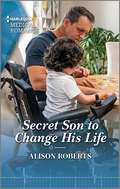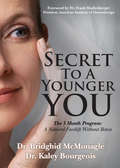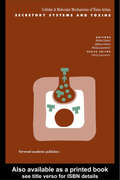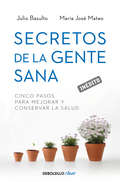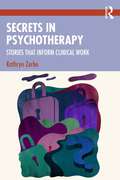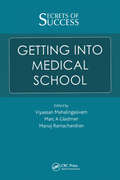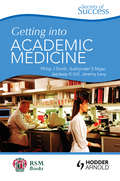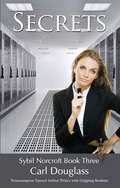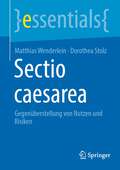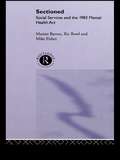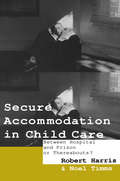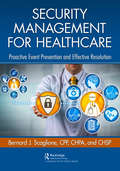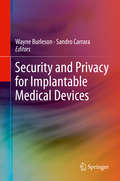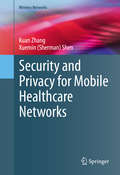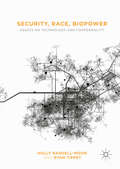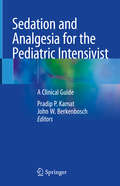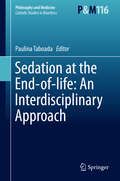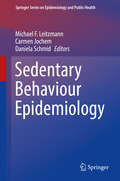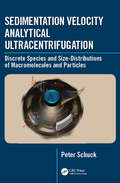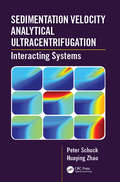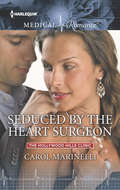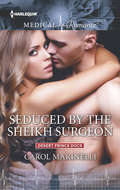- Table View
- List View
Secret Son to Change His Life (Morgan Family Medics #1)
by Alison RobertsA paramedic is in for a shock when his ex reveals a life-changing secret in the first of Alison Roberts's new linked duet, Morgan Family Medics!A surprise reunion……changes everything! Paramedic Jonno&’s memory of Brie is instantaneous when they meet again—and so is their mutual attraction. While Brie can&’t disguise the flutters of excitement Jonno brings out in her, she also knows she now has an opportunity to reveal what she&’s been longing to tell him—he has a son! Jonno wasn&’t planning on sticking around, but maybe Brie can give him a reason to stop running…From Harlequin Medical: Life and love in the world of modern medicine.Morgan Family Medics Book 1: Secret Son to Change His LifeBook 2: How to Rescue the Heart Doctor
Secret to A Younger YOU: The 3 Month Program: A Natural Facelift Without Botox
by Dr. Bridghid McMonagle Dr. Kaley BourgeoisFrustrated by your frown lines? You deserve a natural, non-toxic option to help you regain your youth and your confidence. Don&’t wait to pursue:Improved texture and better skin toneFirmer skin on your face, neck, chest, and handsDrastically minimized fine lines and wrinklesSofter, less visible scarsDr. Bridghid McMonagle and Dr. Kaley Bourgeois designed their protocol to help you look your best without botox, synthetic fillers, or surgery. With Activated Platelets and Ozone, you can look better, and Secrets to a Younger You tells you how.Prioritize the health of your skin today!
Secretory Systems and Toxins (Cellular and Molecular Mechanisms of Toxic Action)
by Philip Lazarovici Michal Linial Alfonso GrassoThis volume deals with the relationships between toxins and one of the most fundamental processes in any living cell - the secretory cycle. The reader will find up-to-date information on secretion, generated by experts in this fast evolving field. In the last decade extensive molecular and cellular studies have exposed the molecular similarity amon
Secretos de la gente sana: Cinco pasos para mejorar y conservar la salud
by Julio Basulto Ma. José MateoUn libro repleto de ideas prácticas para tomar conciencia de nuestra salud, conservarla y mejorarla. Hoy en día la salud se confunde con la estética, con estar delgado, con tomar pastillas y ponerse cremas, como si toda la ayuda para mantenerse sano proviniera de la farmacia. En este libro, los autores nos recuerdan que la mayoría de nosotros nacemos llenos de salud. El secreto de las personas sanas consiste en conservar y aumentar la salud adquiriendo sencillos hábitos beneficiosos y evitando aquello que nos resulta dañino. Con una sólida base científica y nutricional, este libro nos da las claves y los consejos para vivir una vida saludable sin grandes esfuerzos, exigentes dietas o productos farmacéuticos.
Secrets and Scandals: Secret Spy to Top-Secret CIA Mole Hunter (Sybil Norcroft Ser. #4)
by Carl DouglassIn this, the 4th in the Sybil series, Sybil is given an ultra-top-secret clearance rating based on her previous performance and her ice-in- the-veins way of going about the Company's business. Now she has to juggle life as a wife and mother keeping secrets, as a famous public figure in her profession as a network medical consultant news reporter, and as a CIA agent who is under threat of assassination from an unseen and unnamed mole in the intelligence community. When three of her fellow agents are murdered, Sybil is offered the job of finding the mole which considerably increases her chances of meeting harm. What she does will involve secrets and scandals at the highest level of government.
Secrets in Psychotherapy: Stories that Inform Clinical Work
by Kathryn ZerbeThis book brings together contemporary perspectives from psychodynamic treatment, advances in cognitive science, medicine, and neuroscience in a user-friendly format guiding practitioners from beginner to more advanced practitioner in working with secrets that emerge during psychotherapy.Despite their ubiquity in life and in clinical practice, secrets and secret-keeping receive limited attention in the training and skill set required for mental health clinicians. Drawing on personal experience and clinical expertise as well as film, memoir, and literature, Dr. Kathryn Zerbe shares how secrets come to light in both life and treatment, demonstrating the powerful hold that secrets can have on our lives. This book offers a fresh take on how we view our secrets, and how we can use them as a tool to sustain our most intimate and valued connections over the course of a lifetime. Using cutting-edge research as well as honed clinical expertise, the author suggests how one might go about managing the secrets of everyday living that we must keep as well as how we can identify which we can let go. Particular attention is paid to the mind/body relationship and somatic countertransference reactions. Each chapter suggests guidelines to promote wellness and resilience in the secret keeper, whether that be the psychotherapist or their patient.Written with compassion and in a user-friendly style, Secrets in Psychotherapy will benefit anyone who is navigating the thorny terrain of keeping a secret for themselves or someone they know. It is an essential read for psychotherapists, psychoanalysts, and practicing mental health professionals of all disciplines.
Secrets of Success: Getting Into Medical School
by Viyaasan Mahalingasivam; Marc A Gladman; Manoj RamachandranApplying to medical school has become increasingly competitive, with greater numbers of students applying every year. Applicants must take every available opportunity to make themselves stand out amongst the competition if they want to have a chance of getting into the school of their choice. Secrets of Success: Getting into Medical School is written for all potential medical students and is intended to guide applicants on making the right choices in choosing schools and optimizing their performance in the application process.
Secrets of Success: Getting into Academic Medicine
by Philip Smith Jasdeep Gill Sukhjinder Nijjer Jeremy LevyGetting into Academic Medicine provides a comprehensive yet accessible guide for all doctors who are training to gain postgraduate qualifications and further their academic career. It explains what an academic career involves from diploma and masters courses through to completing a PhD and holding professional positions.How to prepare the ideal suc
Secrets of the 17th Century Medicine Cabinet
by Katherine KnightWhat was medicine like in the time of Shakespeare and Oliver Cromwell? How did Charles I cure a headache, or Samuel Pepys get rid of kidney stones? Katherine Knight opens up the delights of the Stuart medicine cabinet in this fascinating romp through seventeenth-century medicine and cosmetics. Documenting the all-important use of household substances and do-it-yourself remedies, this book looks at the emergence of modern medicine from everyday cures such as herbs, oils and foods.Offering solutions for all sorts of nasty afflictions, from digestive disturbances to sexually transmitted diseases, it also describes how our seventeenth-century counterparts enjoyed the benefits of soap, moisturiser and toothpaste. With insights into the lives of those who lived in this remarkable period, Secrets of the 17th Century Medicine Cabinet is more than a medical history - it is an intimate investigation into the private lives of the spirited Stuarts.
Secrets: Public Celebrity to CIA Secret Spy (Sybil Norcroft Ser. #3)
by Carl DouglassIn Secrets, Dr. Sybil Norcroft feels as if she has gotten in over her head in a welter of secrets and conflicts. She undergoes a lie detector test, gets a major national award, and gets inveigled into a secret association with the CIA, all in a dizzyingly brief period of time. She used to think her career as a practicing neurosurgeon was serious; but, after she is vetted for her CIA position, she gains a new appreciation for "serious". The director asks her, "After you are actively engaged in Company work, failing the lie detector test may mean a Company trial and swift and sure justice--the least noxious being dismissal. Any questions about the seriousness of that kind of justice?" Sybil felt chilly after completing that line of questioning. Her first assignment is to hack into the Russian president's computer system. The second assignment is to kill a man. What on earth has this nice lady from California gotten herself into?
Sectio caesarea: Gegenüberstellung von Nutzen und Risiken (essentials)
by Matthias Wenderlein Dorothea StolzDie Sectio-Rate um 30% ist bestimmt vom Sicherheitsbedürfnis. Der BGH entschied eine Mitbestimmung der Schwangeren beim Geburtsmodus. Sectio-Risiken können die Kreißsaal-Akteure weiter reduzieren. Der nachhaltige Nutzen rechtzeitig durchgeführter Sectio ist objektiv darzustellen. Von Beckenbodenschäden infolge vaginaler Geburt ist ca. die Hälfte der Frauen mehr oder minder betroffen. Vaginale Geburte nach Sectio erhöht das Risiko für eine Uterus-Ruptur. Ohne vorausgehende OP beträgt das Risiko 7 pro 1.000 Geburten. Individuell sind Art, Ausmaß und Lokalisation vorausgehender Läsionen zu klären. Sectio-Kinder haben später mehr Auto-Immunerkrankungen im Promillebereich.Das lässt sich reduzieren und vermeiden durch Kontamination der Neugeborenen-Mundhöhle mit mütterlichem Vaginalsekret direkt nach Sectio, relevant für die sofort beginnende Immunentwicklung. Elektive Sectio um die 38. SSW im Interesse der Klinik-/ Kreißsaal-Organisation kann später vielfältige Entwicklungs-Nachteile bewirken, diese sind im Einschulungs-Alter nachweisbar.
Sectioned: Social Services and the 1983 Mental Health Act
by Franz BrentanoFirst published in 1990. Routledge is an imprint of Taylor & Francis, an informa company.
Secure Accommodation in Child Care: 'Between Hospital and Prison or Thereabouts?'
by Robert Harris Professor Noel Timms Noel TimmsFor some children secure accommodation seems to be the only way to control their disparate number of "problems". But why is this so, and from what criteria do social work professionals decide that a child should be put into secure accommodation? In Secure Accommodation in Child Care the authors use an empirical study of secure accommodation as a basis for an analysis of the relations between the state, the family and the "difficult" child. By looking at court procedures, social workers and the children themselves they explain how professionals and children make sense of their worlds, and how they translate that "sense" into personal or professional action. Secure Accommodation in Child Care is essential reading for social service managers, social policy makers, social workers and health care professionals as well as for students and lecturers of social policy and social work.
Security Management for Healthcare: Proactive Event Prevention and Effective Resolution
by Bernard J. ScaglioneThe healthcare industry is changing daily. With the advent of the Affordable Care Act and now the changes being made by the current administration, the financial outlook for healthcare is uncertain. Along with natural disasters, new diseases, and ransomware new challenges have developed for the healthcare security professional. One of the top security issues effecting hospitals today is workplace violence. People don’t usually act violently out of the blue. There are warning signs that can be missed or don’t get reported or, if they are reported, they may not be properly assessed and acted upon. Healthcare facilities need to have policies and procedures that require reporting of threatening or unusual behaviors. Having preventive policies and procedures in place is the first step in mitigating violence and providing a safe and security hospital. Persons working in the healthcare security field need to have information and tools that will allow them to work effectively within the healthcare climate. This holds true for security as well. Security professionals need to understand their risks and work to effectively mitigate threats. The author describes training techniques that can be accomplished within a limited budget. He explains how to manage staff more efficiently in order to save money and implement strategic plans to help acquire resources within a restricted revenue environment. Processes to manage emergent events, provide risk assessments, evaluate technology and understand information technology. The future of healthcare is uncertain, but proactive prevention and effective resolution provide the resources necessary to meet the challenges of the current and future healthcare security environment.
Security and Privacy for Implantable Medical Devices
by Sandro Carrara Wayne BurlesonThis book presents a systematic approach to analyzing the challenging engineering problems posed by the need for security and privacy in implantable medical devices (IMD). It describes in detail new issues termed as lightweight security, due to the associated constraints on metrics such as available power, energy, computing ability, area, execution time, and memory requirements. Coverage includes vulnerabilities and defense across multiple levels, with basic abstractions of cryptographic services and primitives such as public key cryptography, block ciphers and digital signatures. Experts from Computer Security and Cryptography present new research which shows vulnerabilities in existing IMDs and proposes solutions. Experts from Privacy Technology and Policy will discuss the societal, legal and ethical challenges surrounding IMD security as well as technological solutions that build on the latest in Computer Science privacy research, as well as lightweight solutions appropriate for implementation in IMDs.
Security and Privacy for Mobile Healthcare Networks
by Xuemin Sherman Shen Kuan ZhangThis book examines state-of-art research on designing healthcare applications with the consideration of security and privacy. It explains the Mobile Healthcare Network (MHN) architecture and its diverse applications, and reviews the existing works on security and privacy for MHNs. Critical future challenges and research problems are also identified. Using a Quality-of-Protection perspective, the authors provide valuable insights on security and privacy preservation for MHNs. Some promising solutions are proposed to accommodate the issues of secure health data transmission, misbehavior detection, health data processing with privacy preservation and access control in MHNs. Specifically, the secure health data aggregation explores social spots to help forward health data and enable users to select the optimal relay according to their social ties and health data priority. The secure aggregation achieves the desirable delivery ratio with reasonable communication costs and lower delay for the data in different priorities. A proposed misbehavior detection scheme distinguishes Sybil attackers from normal users by comparing their mobile contacts and pseudonym changing behaviors. The detection accuracy is high enough to resist various Sybil attacks including forgery. In addition, the health data processing scheme can analyze the encrypted health data and preserve user's privacy at the same time. Attribute based access control can achieve fine-grained acces s control with user-defined access policy in MHNs. Security and Privacy for Mobile Healthcare Networks is designed for researchers and advanced-level students interested in healthcare security and secure data transmission.
Security, Race, Biopower
by Holly Randell-Moon Ryan TippetThis book explores how technologies of media, medicine, law and governance enable and constrain the mobility of bodies within geographies of space and race. Each chapter describes and critiques the ways in which contemporary technologies produce citizens according to their statistical risk or value in an atmosphere of generalised security, both in relation to categories of race, and within the new possibilities for locating and managing bodies in space. The topics covered include: drone warfare, the global distribution of HIV-prevention drugs, racial profiling in airports, Indigenous sovereignty, consumer lifestyle apps and their ecological and labour costs, and anti-aging therapies. Security, Race, Biopower makes innovative contributions to multiple disciplines and identifies emerging social and political concerns with security, race and risk that invite further scholarly attention. It will be of great interest to scholars and students in disciplinary fields including Media and Communication, Geography, Science and Technology Studies, Political Science and Sociology.
Sedation and Analgesia for the Pediatric Intensivist: A Clinical Guide
by Pradip P. Kamat John W. BerkenboschThis book provides a comprehensive overview on sedation and analgesia for the pediatric intensivist. Divided into two primary sections, the text presents a framework on how to care for patients who need sedation, analgesia, and neuromuscular blockade inside the pediatric ICU (PICU), and how to manage procedural sedation in an outpatient setting. The first section focuses on sedation and analgesia for the critically ill child, with an emphasis on analgesics, sedatives, neuromuscular blockade, tolerance and withdrawal, and the PICU environment. The second section centers around procedural sedation, detailing patient selection, pre-sedation assessment, how to choose a sedation regimen, available agents, and nursing considerations.Written by experts in the field, Sedation and Analgesia for the Pediatric Intensivist: A Clinical Guide is a valuable resource for the pediatric intensivist in caring for their patients both inside and outside the PICU.
Sedation at the End-of-life: An Interdisciplinary Approach
by Paulina TaboadaThe book's main contribution is its interdisciplinary approach to the issue of sedation at the end-of-life. Because it occurs at the end of life, palliative sedation raises a number of important ethical and legal questions, including whether it is a covert form of euthanasia and for what purposes it may legally be used. Many of the book chapters address the first question and almost all deal with a specific form of the second: whether palliative sedation should be used for those experiencing "existential suffering"? This raises the question of what existential suffering is, a topic that is also discussed in the book. The different chapters address these issues from the perspectives of the relevant disciplines: Palliative Medicine, Bioethics, Law and Theology. Hence, helpful accounts of the clinical and historical background for this issue are provided and the importance of drawing accurate ethical and legal distinctions is stressed throughout the whole book. So the volume represents a valuable contribution to the emerging literature on this topic and should be helpful across a broad spectrum of readers: philosophers, theologians and physicians.
Sedentary Behaviour Epidemiology
by Michael F. Leitzmann Carmen Jochem Daniela SchmidThis book addresses the origins, determinants and magnitude of the global problem of sedentary behaviour, along with concise yet in-depth solutions for tackling it. As a consequence of major technological advances in modern society, many people find themselves in environments characterized by prolonged sedentary behaviour. Although inadequate exercise has long been known to cause adverse health consequences, sedentary behaviour has recently emerged as a risk factor for the development of numerous chronic diseases and health conditions. Building on the contributions of leading experts in the field, this book presents current knowledge about sedentary behaviour, its medical and public health significance, its correlates and determinants, measurement techniques, and recommendations for addressing this behaviour at the individual, community, environmental, and policy level. Applying a cross-disciplinary methodology, the book avoids considering physical activity and sedentary behavior as a single continuum, which potentially hampers progress in confronting widespread levels of sedentariness. Rather, the book helps readers better understand how sedentary and physically active behavior co-occur and how the two behaviours have distinct contributing factors. Building on the contributions of distinguished international experts in the field, this thorough resource is a valuable asset and challenges professionals, researchers, students, and practitioners alike to adopt new strategies and expand their reach.
Sedentary Behaviour Epidemiology (Springer Series on Epidemiology and Public Health)
by Michael F. Leitzmann Carmen Jochem Daniela SchmidThis book addresses the origins, determinants and magnitude of the global problem of sedentary behaviour, along with concise yet in-depth solutions for tackling it. As a consequence of major technological advances in modern society, many people find themselves in environments characterized by prolonged sedentary behaviour. Building on the contributions of leading experts in the field, the new edition of this book presents updated knowledge about sedentary behaviour, its medical and public health significance, its correlates and determinants, measurement techniques, and recommendations for addressing this behaviour at the individual, community, environmental, and policy level. The book encompasses current research linking the COVID-19 pandemic to increased levels of sedentary behavior, and it covers global and planetary health aspects of sedentary behavior, highlighting sustainable development goals such as health and well-being for all. Applying a cross-disciplinary methodology, the book avoids considering physical activity and sedentary behavior as a single continuum, which potentially hampers progress in confronting widespread levels of sedentariness. Rather, the book helps readers better understand how sedentary and physically active behavior co-occur and how the two behaviours have distinct contributing factors. Building on the contributions of distinguished international experts in the field, this thorough resource is a valuable asset and challenges professionals, researchers, students, and practitioners alike to adopt new strategies and expand their reach.
Sedimentation Velocity Analytical Ultracentrifugation: Discrete Species and Size-Distributions of Macromolecules and Particles
by Peter SchuckA follow-up to the experimental and instrumental aspects described in Basic Principles of Analytical Ultracentrifugation, the volume Sedimentation Velocity Analytical Ultracentrifugation: Discrete Species and Size-Distributions of Macromolecules and Particles describes the theory and practice of data analysis. Mathematical models for the sedimentation process and the evolution of detected signals are developed in a comprehensive framework, jointly with the description of current and historical strategies for how to extract from noisy experimental data the physical parameters of interest, such as size, mass, and shape, composition, and polydispersity of sedimenting particles. The methods are extensively illustrated, and supported with practical applications, as well as cross-references where to find the methods in the public domain software SEDFIT and SEDPHAT. The systems covered are discrete or polydisperse mixtures of sedimenting molecules or particles in dilute solution, such as proteins and other biomolecules and their stable complexes, man-made polymers, and nanoparticles, observed in different optical systems. A useful reference for researchers and graduate students of macromolecular disciplines, these methods form the essential foundation for the analysis of dynamic interacting systems, which are covered in the volume Sedimentation Velocity Analytical Ultracentrifugation: Interacting Systems. Software referenced in the book is available for download at: https://sedfitsedphat.nibib.nih.gov/default.aspx
Sedimentation Velocity Analytical Ultracentrifugation: Interacting Systems
by Peter Schuck Huaying ZhaoAnalytical ultracentrifugation is one of the most powerful solution techniques for the study of macromolecular interactions, to define the number and stoichiometry of complexes formed, and to measure affinities ranging from very strong to very weak and repulsive. Building on the data analysis tools described in the volume Sedimentation Velocity Analytical Ultracentrifugation: Discrete Species and Size-Distributions of Macromolecules and Particles, and the experimental and instrumental aspects in the first volume Basic Principles of Analytical Ultracentrifugation, the present volume Sedimentation Velocity Analytical Ultracentrifugation: Interacting Systems is devoted to the theory and practical data analysis of dynamically coupled sedimentation processes. This volume is designed to fill a gap in biophysical methodology to provide a framework that builds on the fundamentals of the highly developed traditional methods of analytical ultracentrifugation, updated with current methodology and from a viewpoint of modern applications. It will be an invaluable resource for researchers and graduate students interested in the application of analytical ultracentrifugation in the study of interacting systems, such as biological macromolecules, multi-protein complexes, polymers, or nanoparticles.
Seduced by the Heart Surgeon
by Carol MarinelliOne night with a playboy... As head of PR for the elite Hollywood Hills Clinic, ex-socialite Freya Rothsberg knows image is everything. Yet her own facade of calm control is shattered when she meets outrageously sexy heart surgeon Zack Carlton at a wedding. One wild night of passion later, Freya is shocked to realize that Zack is the clinic's newest recruit! Playboy Zack exposes Freya's every secret yearning for a fairy-tale ending. He's an expert with damaged hearts-does she dare trust him with hers?
Seduced by the Sheikh Surgeon
by Carol MarinelliThe sheikh's temptation! Handsome A&E consultant Sheikh Zahir has always seemed out of reach to nurse Adele Jenson. But when his mother needs medical care and requests Adele's help, she finds herself being swept off to Zahir's desert kingdom! Adele's unexpected trip is the first time she's truly let herself live since the accident that has overshadowed her life. But when Zahir reveals his craving for her, Adele's guard completely falls. Just one passionate night in the desert makes her wonder-will this brooding sheikh choose his crown...or her?
